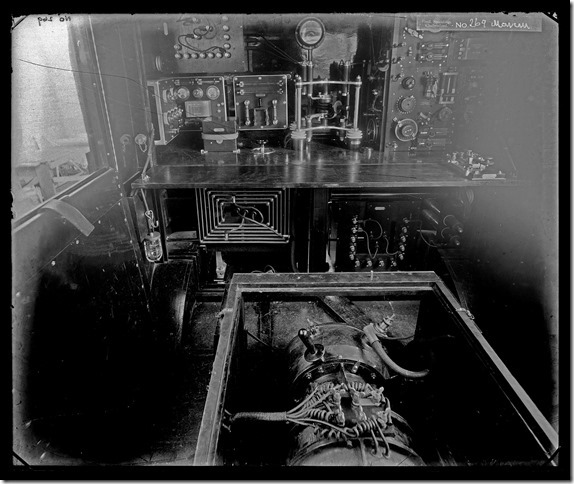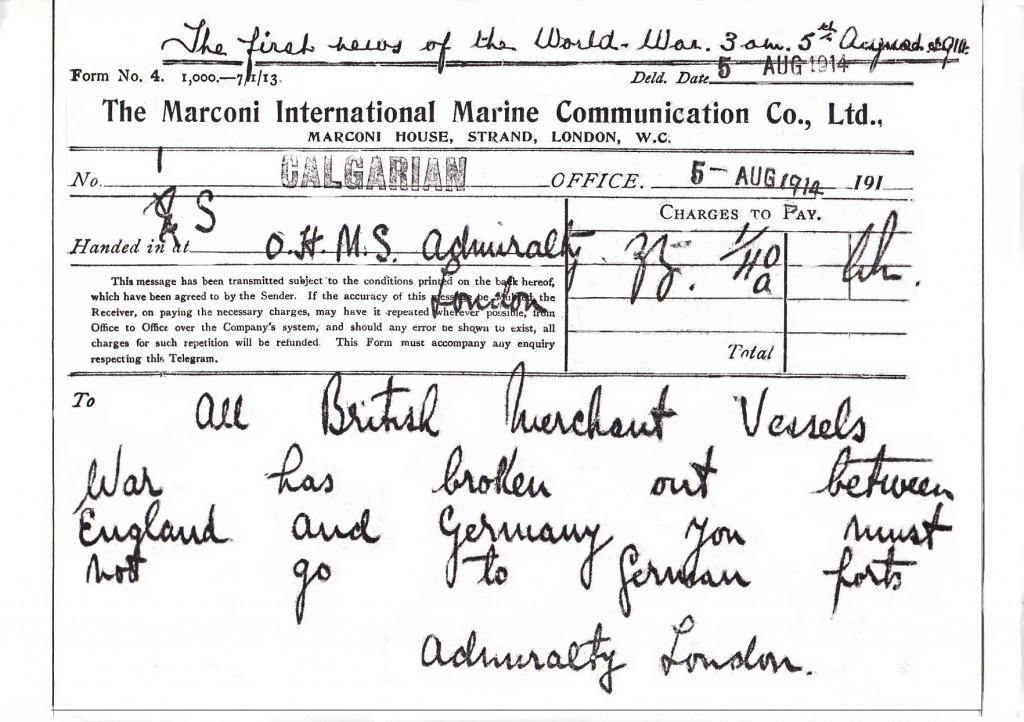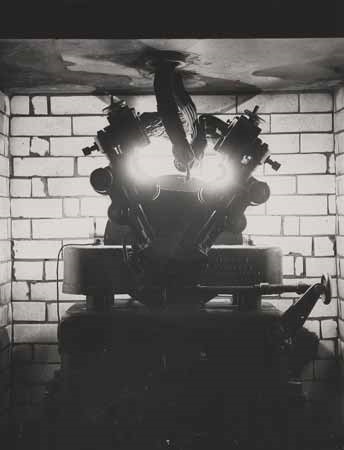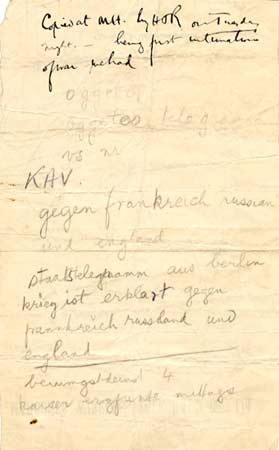
First World War Centenary Commemorations 2014 - 2018
Over the coming four years there will be a focus on the use of wireless by all three armed services during the conflict, together with references to related activities both locally in Essex and nationally.
During WWI, the British Navy was faced with the possibility of action in any of seven seas and set about creating its own world communication network for its scattered fleets. Marconi's Wireless Telegraph Company was contracted to build a dozen stations on widely separated and sometimes isolated sites.
The development of mobile wireless sets was a crucial part of the war effort. As early as 1902 the British War Office had an interest in military portable stations and official tests were undertaken. This resulted in transportable wireless stations being used during British Army manoeuvres in 1903. These sets used demountable umbrella-type antennae, syntonic tuned transmitters and reception by magnetic detectors.
The early army wireless installations were carried by horse-drawn wagons. Later Marconi looked at developing transportable sets housed in self-propelled vehicle, in particular installed in a Star motor car:


As part of this initiative we have become a member of the First World War Centenary Partnership being coordinated by the Imperial War Museum – our entry can be seen here and another Chelmsford entry here.
As a general introduction, and to show the extensive involvement by Marconi, a series of documents which outline the supply of equipment, the drafting of personnel and the design and production in laboratories and factories is mounted here:
The Marconi Company - Wireless Goes to War - 1914 -1918

Text reads:
YOUNG MEN
BETWEEN THE AGES OF 16 AND 18,
SERVE YOUR COUNTRY AS
WIRELESS OPERATORS
EXEMPTION FROM MILITARY SERVICE
Official Government Statement.
'Owing to the present urgent demand for Wireless Operators in the Mercantile Marine, students entering the school prior to their eighteenth birthdays, and making such progress that they are able to obtain the necessary certificates on or before reaching the age of 181/4, will be temporarily exempted from military service until a sufficient number of Operators has been obtained. This exemption continues so long as students of military age who have passed into the Mercantile Marine are employed as Operators at sea.'
Free Training. Good Pay. Permanent Positions.
Write or call for full particulars to
THE MARCONI REPRESENTATIVE
City School of Wireless Telegraphy, 4 Bridlesmith Gate, NOTTINGHAM.
The involvement of Marconi radio officers was vital to the conduct of the war - this is an extract from the book by H.E. Handcock, Wireless at Sea: the First Fifty Years (Chelmsford, 1950)
Immediately on the outbreak of war the Admiralty took steps to secure the services of Marconi operators for all branches of the service. In answer to the Government’s call there came an army of lads and young men from all classes who had gone from school to the Marconi Marine Company, in whose offices they had trained in Morse and the operation and maintenance of wireless apparatus. These at once volunteered their services to the Admiralty and the War Office, their places being taken by other lads clamouring to be trained as wireless operators. In due course the Company provided not merely an army of operators (3300 men were trained during the war), but also technical experts whose knowledge was unrivalled and whose service to the country many tributes were made.
The Company kept its offices open day and night for the purpose of examining lads who came from all parts of the country to offer themselves as operators. So great was the demand, that some of the pupils and enrolled scholars were as young as sixteen years. The staff at Marconi House worked to the limits of their power and to the last ounce of their energy to meet the great emergency. Every ship that arrived at a British port with a wireless operator on board brought a volunteer to the Admiralty. These men were taken in their hundreds from the Merchant Navy and distributed as quickly as possible among ships of war of all types from the battleship to the armed trawler.
But although the Navy’s problem was being solved another was being created in the Merchant Fleet. Not only were the big liners deprived of their Marconi operators but ships which hitherto had not been fitted with wireless (vessels of 1600 to 3000 tons) found that wireless was a necessity. In addition, whereas before the war it was sufficient for one operator to be carried, now it was essential that there should be at least two operators to keep a continual vigil.
A conference was held at the Admiralty for the purpose of considering the practicability of fitting all ships of 1600 tons and over with wireless telegraphy. The desirability of carrying two operators for maintaining continuous watch was also emphasised, the authorities thereupon approached the Marconi Company with the view of ascertaining whether they could possibly cope with so huge a task. Few ships under 3000 tons had up to date been fitted, and it was quite evident that not only would a tremendously increased volume of wireless apparatus have to be made and supplied, but that the operating staff would need to be practically trebled. It was estimated, in other words, that the trained personnel, already increased in three years from 1000 to nearly 3000 men, would have to be expanded to a total of about 4000 to 4500 in a few months. With the full knowledge of this gigantic task, Mr. Godfrey Isaacs, on behalf of the Company, undertook definitely to provide both apparatus and men.
Arrangements were made for a course of free tuition, and the accommodation of Marconi House being filled to overflowing, arrangements were made with King’s College and Birbeck Institute for the reception of additional volunteers. Similar schemes were set afoot in several provincial centres. At the same time, pressure of a severe nature was put upon the Marconi Works at Chelmsford. The delicate mechanism employed in wireless telegraphy, with the Company’s research and development and the constant improvements being introduced by experts at headquarters, had to be manufactured at speed and in such quantity as never before had been contemplated. And, in addition, there was a constant demand for those simpler instruments – keys, buzzers, telephones, etc, which are necessary for the instruction of pupils. The manner in which this problem was handled is beyond praise.”
Arriving For Instructions In Wireless - Telegraphy At Marconi House (1919)
This document on the Radio Officers Association website covers both world wars so has to be scrolled seven-eights of the way through to reach the section on WW1 which is the Memorial Register of Marconi Marine Wireless Operators Lost at Sea 1914 to 1918

Poldhu - Station ZZ ~ was used to send details of the declaration of the First World War on August 4th 1914

The Spark Transmitter as it was actually sending the message from the Admiralty warning all British and Allied vessels not to go to German ports.
This message is written in pencil on the reverse of a Marconi's Wireless Telegraph Company internal order form. It is the transcription of a wireless message intercepted by H.J. Round at Marconi House. The note is annotated in ink 'Copied at MH by HJR on Tuesday night- being first intimation of war we had'

A report issued by English Heritage - First World War Wireless stations in England
Inovating in Combat 1- telecommunications in WW1
An item broadcast as part of the BBC WW1 Commemoration.
An article concerning the us of D/F and intelligence gathering
An extract from Film Number: IWM 269 |
|
W F Massey and Sir Joseph Ward, Prime Minister and Minister of Finance of New Zealand, visit the New Zealand Division near the Bois de Warnimont, St-Léger sector, Western Front, 30 June-2 July 1918. |
|
At the 3rd NZ Rifle Brigade, accompanied by the brigade commander Colonel Stewart, they watch a demonstration of an aeroplane dropping a message and Ward takes part in a wireless demonstration.
This is a series of pictures extracted from The Marconigraph 1911 volume showing horse-mounted wireless equipment for deployment round the battlefield.
This is a photograph of an RAF officer on Army manoeuvres in 1925 - post-war but still using the cart-mounted version of the wireless equipment
Extract from Bodleian Archive
Miscellaneous papers relating to wireless in World War 1, 1914-18
Shelfmark: MS. Marconi 358
Extent: 1 folder
Includes
Scope and Content:
note of an intercepted wireless message in German announcing the outbreak of war, copied down by H.J. Round, 1914
letter from Godfrey Isaacs to Guglielmo Marconi advising that experiments with America are not possible, reporting on speculation as to the side Italy will take in the war, and referring to the hope of concluding the contract for the Imperial stations, Sept. 1914
letter from the Home Office advising it is not possible to grant exemption to Marconi from the Alien Restrictions Order to allow him to travel more freely, Nov. 1914
correspondence with the War Office about a visit by Marconi to the headquarters in France, 1915
letter from Lord Kitchener to Marconi in appreciation of Marconi's success in organising the manufacture of cartridges for rifles loaned by the Italian Government to Russia, 1915
wartime annual report of the U.S. Naval Radio Service, 1915
copies of the message announcing the cessation of hostilities, with related papers, Nov. 1918
letter from Field Marshal Douglas Haig to the Wireless Press Ltd., expressing thanks for the services performed by wireless telegraphists throughout the war, 1918
letter from Admiral David Beatty to Marconi, expressing thanks for the service of wireless ratings, operators and equipment in HM Navy, 1918
letter from W.R. Cross, Marconi International Marine Communication Company Traffic Manager, to H.W. Allen giving a history of the work of the department during the war, including details of the recruitment and training of ships' radio officers, 1921summary of Roll of Honour for the company, c.1918
Relevant links
Museum of the History of Science